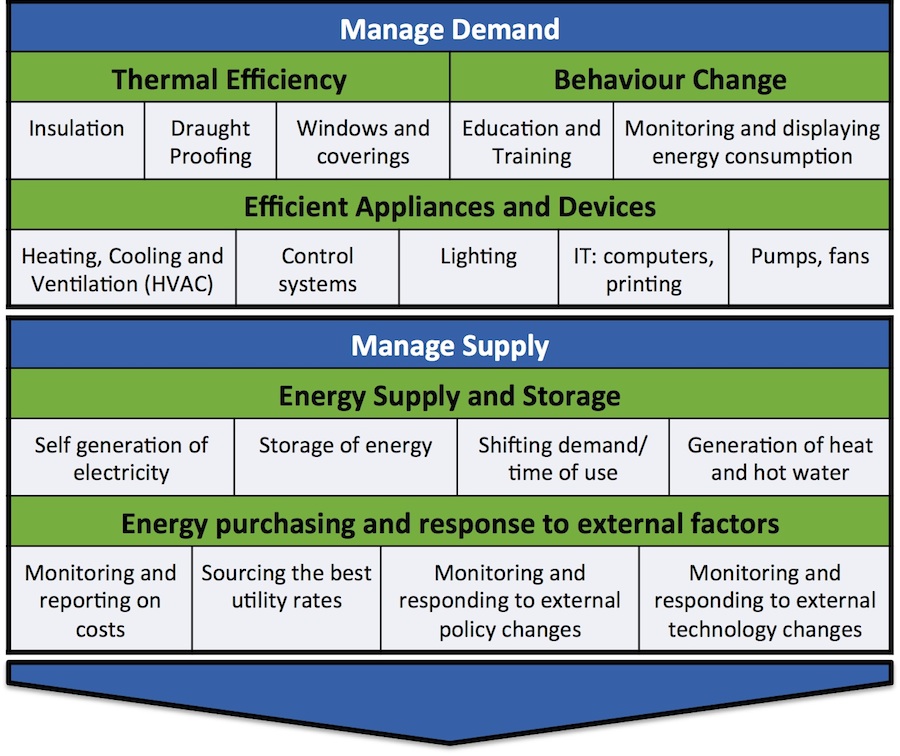The energy supply and demand (usage) decisions made by organisations are critical business decisions. Organisations are exposed to the increasing cost of energy supply, in an environment where the government policy landscape is changing, international trade opportunities for the nation are resulting in sharp increases in domestic charges (e.g. for gas), and technological innovation is opening up opportunities to rethink the way energy is used.
Your ‘energy architecture’ is a representation of how you source and use energy to run your business or household, now and in the future. It sets out how you use energy – the appliances used for heating and cooling, hot water and ventilation; the choices you make around passive infrastructure such as insulation, draught-proofing and windows; the behaviours of you and your staff in operating your facilities. It sets out how you source energy – your suppliers and the contracts you have in place; the rates you are paying. It enables you to decide whether the time is right to adopt emerging self-generation technologies (e.g. Solar with Storage) (can you go ‘off the grid’?); whether the changing policy environment is actually an opportunity that may enable you to change your business.
Your energy architecture is a framework for understanding and changing energy usage in your organisation. It is not simply about energy supply rates – improving building comfort and lowering consumption is much more important – but all elements of the architecture need to be assessed and understood.
Efficient Initiatives’ Energy Efficiency Framework:

Lower Energy Consumption and Cost
Improved Resident, Student and Client Comfort
Enhanced Staff Productivity
An Integrated Process
Efficient Initiatives develops and uses an energy architecture as part of an integrated process, specifically customised for your situation, in assessing your current energy usage, behaviours, problems and potential solutions. The energy architecture is a means to an end, enabling the development of conceptual and detailed designs, project plans and financing that have been proven to offer potential saving in the order of 50% of energy costs while improving comfort and productivity.
Avoiding Paralysis
The apparent complexity of government energy and environment policy, climate change, technological innovation, the energy supply chain (generation, distribution, retail) and relentless cost increases can lead to a kind of decision-making paralysis, whereby it all seems too hard and organisations look only to the easy answers – e.g. change your energy retailer to get a better rate. This leads to the implementation of sub-optimal point solutions, or even non-solutions, as the rate you commit to today may not be the best rate tomorrow.
An Efficient Initiatives engagement ends decision-making paralysis by developing your strategic energy architecture and clarifying your energy future. Your energy future will almost certainly involve getting the best rates, but our experience proves that an integrated, architected solution that addresses all areas will lower costs by permanently lowering consumption. It comprises:
1. Assessment:
- Energy bill review
- Walkthrough of site to identify major energy consumers and potential problems
- Scope works for Audit
2. Energy Audit:
- Analyses your buildings, consumption patterns, occupancy behaviours and maintenance
- Provides practical advice on reduction strategies, typically covering insulation, draught-proofing, heating and cooling, hot water, solar electricity, lighting, equipment, behaviour change or more sophisticated options
- Reviews your energy bills and contracts and assesses options for change
- Draws on our deep technical knowledge to identify a range of energy reduction solutions, their costs, benefits and payback periods and the impacts on your facility
3. Detailed Design:
- Delivers specifications and implementation plan and project schedule
- Seeks fixed prices to from contractors/ suppliers
- Enables low cost finance for the selected implementation projects
4. Efficiency Implementation:
- Uses a dedicated Project Manager as your single point of contact and accountability
- Enables you to concentrate on your business while we manage the retrofit
- Ensures that the efficiency concepts identified during the audit become reality – safely delivering the best outcomes for your business and residents
5. Ongoing Monitoring and Reporting:
- Can integrate with your existing Maintenance or Building Management Systems
- Delivers live data and useful information, via the web, to your staff and stakeholders
- Allow you to keep control of your energy consumption and costs
- Identifies future opportunities for improvement
